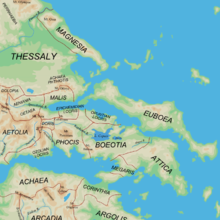Magnesia (Thessaly)
Magnesia ( Greek Μαγνησία ( f. Sg. )) Describes a Thessalian landscape in ancient Greece , today part of the Magnisia regional district .
The area stretched in a narrow strip along the Aegean Sea , from the Peneus River in the northwest to the foothills of the peninsula that encloses the Gulf of Pagas . The mountain ranges of Ossa and Pelion shape the landscape.
The inhabitants of Magnesia were called magnets ( Greek Μάγνητες , Mágnētes ). They were among the first founding members of the Amphiktyonenbund - along with the Dolopers , Ainians , Malians , Phthiotes and Perrhäbern . The largest city in the region was Iolkos ; today's Volos lies directly below the ancient site. According to legend, the ancient city of Magnesia am Meander in Asia Minor was founded by the magnets a generation before the Trojan War, probably also another, Magnesia am Sipylos , which was located further north on the Hermos in Lydia .
In Greek mythology , magnes is the eponym of magnesia. From Iolkos, Jason is said to have set out with the Argonauts to get the Golden Fleece .
literature
- Friedrich Stählin : Magnesia 1. In: Paulys Realencyclopadie der classischen Antiquity Science (RE). Volume XIV, 1, Stuttgart 1928, Col. 459-471.
- Ernst Meyer : Magnesia 1. In: The New Pauly (DNP). Volume 9, Metzler, Stuttgart 2000, ISBN 3-476-01479-7 , Sp. 693-695.
Individual evidence
- ^ Fritz Graf : Amphiktyonie. In: The New Pauly (DNP). Volume 1, Metzler, Stuttgart 1996, ISBN 3-476-01471-1 , Sp. 611.
- ^ Adolf Schirmer : Magnes . In: Wilhelm Heinrich Roscher (Hrsg.): Detailed lexicon of Greek and Roman mythology . Volume 2.2, Leipzig 1897, column 2233 ( digitized version ).
- ↑ Herwig Kramolisch: Iolkos. In: The New Pauly (DNP). Volume 5, Metzler, Stuttgart 1998, ISBN 3-476-01475-4 , Sp. 1073 f.
